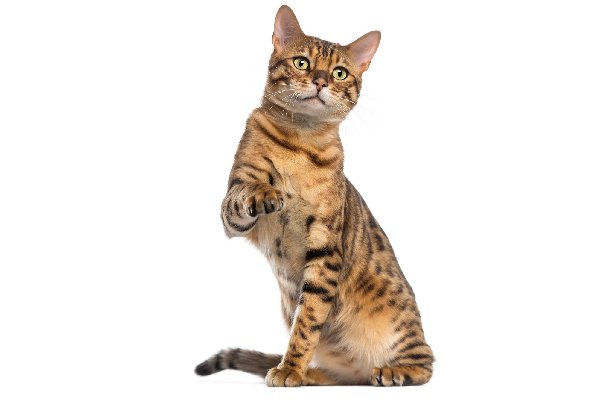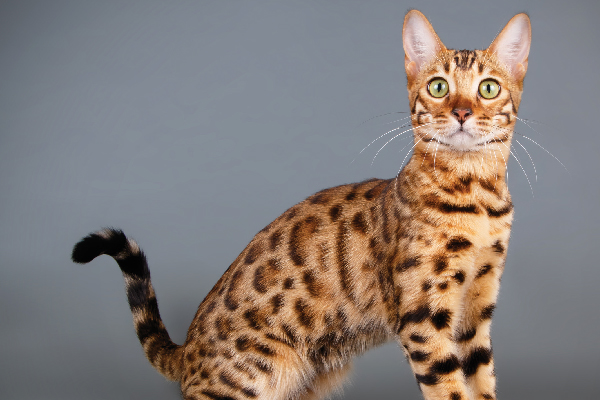Who isn’t in love with the spotted coat patterns of the ocelot, the margay, the leopard and other wild cats? But keeping them as pets is problematic both ethically and as a matter of day-to-day living. Wild cats don’t lie in your lap and purr, and their destructive capability is several orders of magnitude greater than that of a domestic cat. Enter such spotted cat breeds as the Ocicat, Egyptian Mau, Toyger, Savannah and Bengal: domestic cats created to have the look of the wild cat but not the temperament. Bengals are among the most popular of the wild cat look-alikes, not only for their spots, rosettes or marbling but also for their active, smart and vocal nature.
A day in the life of a Bengal

Bengal expert Anthony Hutcherson, who fell in love with the cats when he was a teenager, says a Bengal’s perfect day is to wake his human with a purr and supervise toothbrushing and other ablutions — sometimes from inside the shower.
After their people leave for work, Bengals tend to their hobbies, which include climbing to the top of the highest cat tree, looking out windows and performing their daily cardio regimen on the cat tree. Post-dinner antics include running across the living room, fetching their favorite toy again and again, and doing a little lap- or keyboard-sitting. They’re good at figuring out how to open doors, turn water faucets on and off, and flush the toilet, among other things.
What families are best for a Bengal?
Like all felines, though, Bengals appreciate routine. “If they were picking a family, they would choose someone interesting that had a variety of daily activity but that also had a regular routine,” Anthony says. “They like to know when their morning starts, when they can expect to be fed, and when they can expect things to calm down and be quiet for bed. They really enjoy that and become their best selves that way.”
Bored Bengals get into everything, including closets, cabinets and drawers, says Canie Brooks, an authority on the breed. They do best with a buddy to entertain them when their people aren’t at home. That can be another cat or a small dog, Canie says. Favorite toys include feather teasers and balls that they can chase and retrieve.
Who might not get along with a Bengal?

Don’t choose a Bengal if you won’t enjoy a cat who is always in your face, wanting to be involved in whatever you’re doing. “If they don’t have a buddy, you become their toy, and they have been known to stalk their owners,” Canie says. “They are just trying to play, but some have found it annoying.” Once they have run off their energy on a cat wheel and feel appreciated for the show they put on with their antics, Bengals may consider snuggling next to you while you watch TV, but don’t count on them to enjoy being held or hugged. They’d rather interact with you by learning tricks, playing fetch or walking on a leash.
Don’t expect a Bengal to be a wild child in terms of temperament. Sometimes people have an expectation that a Bengal, because of its “wild” ancestry, will have undesirable behaviors that aren’t seen in the average pet cat, but a Bengal should not behave in any more unacceptable fashion than any other domestic cat, Anthony says.
A Bengal’s fabulous features
Bengals are best known for their coats. Their fur is dense and luxurious, with a soft, silky feel. The spots or rosettes offer a vivid contrast on the richly colored coats. They are the only domestic cats to have rosettes such as those seen in the coat patterns of jaguars, leopards and ocelots. In some Bengals, the coat seems to sparkle when light hits the tips of the hairs, a phenomenon called glitter. Stanford University researcher Chris Kaelin discovered the gene for glitter when he was seeking the gene for the rosette pattern. It’s a trait from cats imported by breed founder Jean Mill in the early 1980s, Anthony says.
Bengal history
Bengals originated as a cross between Asian Leopard Cats — small wild cats weighing 5 to 12 pounds — and domestic cats. Although this cross had been made a few times in the early 20th century, it was not until the 1960s that breeder Jean Mill began seriously developing the cross-bred cats to create a true domestic feline. She achieved her desired cat in the 1980s, and today’s Bengals come only from Bengal-to-Bengal breedings. Bengals are recognized by the American Cat Fanciers Association, the Cat Fanciers’ Association, the Governing Council of the Cat Fancy and The International Cat Association.
Grooming and health for Bengals
The Bengal coat is easy to care for. A good brushing once a month is plenty, but it’s hard to resist running your fingers through that silky fur on a daily basis. Bengals typically have a long life span of 15 to 20 years. Like any cat, they can be prone to certain health problems, including heart diseases such as hypertrophic cardiomyopathy and dilated cardiomyopathy, and an eye disease called progressive retinal atrophy.
Thumbnail: Photography ©Aleksandr Volchanskiy | Getty Images.








